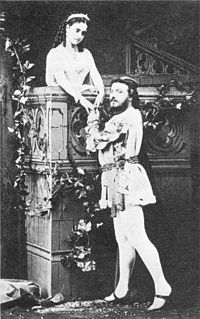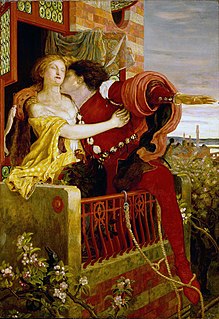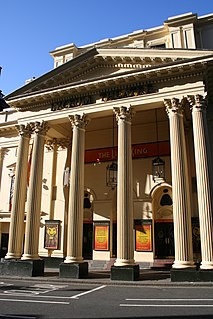
Twelfth Night, or What You Will is a comedy by William Shakespeare, believed to have been written around 1601–1602 as a Twelfth Night's entertainment for the close of the Christmas season. The play centres on the twins Viola and Sebastian, who are separated in a shipwreck. Viola falls in love with Duke Orsino, who in turn is in love with the Countess Olivia. Upon meeting Viola, Countess Olivia falls in love with her thinking she is a man.

Mercutio is a fictional character in William Shakespeare's 1597 tragedy, Romeo and Juliet. He is a close friend to Romeo and a blood relative to Prince Escalus and Count Paris. As such, being neither a Montague nor a Capulet, Mercutio is one of the named characters in the play with the ability to mingle around those of both houses. The invitation to Capulet's party states that he has a brother named Valentine.

Romeo and Juliet, Op. 64, is a ballet by Sergei Prokofiev based on William Shakespeare's play Romeo and Juliet. Prokofiev reused music from the ballet in three suites for orchestra and a solo piano work.

Roméo et Juliette is an opera in five acts by Charles Gounod to a French libretto by Jules Barbier and Michel Carré, based on Romeo and Juliet by William Shakespeare. It was first performed at the Théâtre Lyrique, Paris on 27 April 1867. This opera is notable for the series of four duets for the main characters and the waltz song "Je veux vivre" for the soprano.

Juliet Capulet is the female protagonist in William Shakespeare's romantic tragedy Romeo and Juliet. Juliet is the only daughter of the patriarch of the House of Capulet. She falls in love with Romeo, a member of the House of Montague. The story has a long history that precedes Shakespeare himself.
Laura Rees is a British actress from Northampton.
Romeo.Juliet is the title of a 1990 film version of William Shakespeare's classic play Romeo and Juliet. It was made by American producer, director and cinematographer, Armando Acosta in conjunction with Moonseed Productions using the feral cats of Venice, New York City, and Ghent as actors, with the voices dubbed by some of the greats of the English theatre including Ben Kingsley, Maggie Smith, Vanessa Redgrave, Robert Powell, Francesca Annis, Victor Spinetti, Quentin Crisp, and John Hurt. The score of the film features Serge Prokofiev's 'Romeo and Juliet Ballet' as performed by the London Symphony Orchestra, André Previn conducting and an original theme composed by Armando Acosta and Emanuel Vardi, performed by the London Symphony Orchestra conducted by Barry Wordsworth.
Over fifty films of William Shakespeare's Hamlet have been made since 1900. Seven post-war Hamlet films have had a theatrical release: Laurence Olivier's Hamlet of 1948; Grigori Kozintsev's 1964 Russian adaptation; a film of the John Gielgud-directed 1964 Broadway production, Richard Burton's Hamlet, which played limited engagements that same year; Tony Richardson's 1969 version featuring Nicol Williamson as Hamlet and Anthony Hopkins as Claudius; Franco Zeffirelli's 1990 version starring Mel Gibson; Kenneth Branagh's full-text 1996 version; and Michael Almereyda's 2000 modernisation, starring Ethan Hawke.
Simon Morrison is a music historian specializing in 20th-century music, particularly Russian and Soviet music, with special interests in dance, film, and historically informed performance based on extensive archival research. He is a leading authority on composer Sergey Prokofiev and has received unprecedented access to the composer's papers, housed in Moscow at RGALI. Morrison received his B.Mus. from the University of Toronto (1987), a Master's in Musicology from McGill University (1993), and Ph.D. from Princeton University (1997), where he is Professor of Music. His distinctions include the Alfred Einstein Award of the American Musicological Society (1999), an American Council of Learned Societies Fellowship (2001), a Phi Beta Kappa Society Teacher Award (2006), and a Guggenheim Fellowship (2011).
Radio and Juliet is an hour long ballet setup in 2005 for the Slovenian company Ballet Maribor in Slovenia. It was directed by Romanian dancer and choreographer Edward Clug. The ballet is a rendition of William Shakespeare's Romeo and Juliet set to the music of Radiohead. Since 2005 Radio and Juliet has guested in the Netherlands, Italy, Singapore, Korea, Israel, Canada, United States, Russia, Ukraine, Brazil, Serbia and Croatia. It has also been set on the companies of Bucharest National Theater and Kiev National Opera. On 15 September 2012, the 100th performance was celebrated on the old stage of the Maribor Opera house. The ballet premiered in the United States in 2008 at the Pittsburgh International Festival of Firsts at the Byham Theater.

Mônica e Cebolinha: No Mundo de Romeu e Julieta is a film adaptation of Romeo and Juliet by William Shakespeare, starring Monica's Gang. It was originally staged at theater in 1978 with a comic and LP adaptation out in the same year. In 1979 the feature film adaptation of the play was released, filmed in Ouro Preto, as a special for the Children's Day on Rede Bandeirantes. Along with A Rádio do Chico Bento, is one of the two films inspired by Mauricio de Sousa characters completely done in live-action.

Romeo and Juliet is a 2008 ballet choreographed by Krzysztof Pastor based on William Shakespeare's play Romeo and Juliet. Pastor's three-act version is set to the same score used in the Prokofiev version of the ballet. The libretto is by Pastor and Willem Bruls.
Romeo and Juliet is a 1940 Spanish historical drama film directed by José María Castellví and starring Martha Flores and Enrique Guitart. The film is an adaptation of William Shakespeare's Romeo and Juliet.
Leonid Mikhailovich Lavrovsky (1905–1967) was a Russian ballet choreographer, most famous for choreographing the first full version of Sergei Prokofiev's Romeo and Juliet.
There have been numerous on screen adaptations of Shakespeare's The Taming of the Shrew. The best known cinematic adaptations are Sam Taylor's 1929 The Taming of the Shrew and Franco Zeffirelli's 1967 The Taming of the Shrew, both of which starred the most famous celebrity couples of their era; Mary Pickford and Douglas Fairbanks in 1929 and Elizabeth Taylor and Richard Burton in 1967. On television, perhaps the most significant adaptation is the 1980 BBC Television Shakespeare version, directed by Jonathan Miller and starring John Cleese and Sarah Badel.
Rudolf Nureyev's production of Sergei Prokofiev's Romeo and Juliet premiered at the London Coliseum on 2 June 1977.













